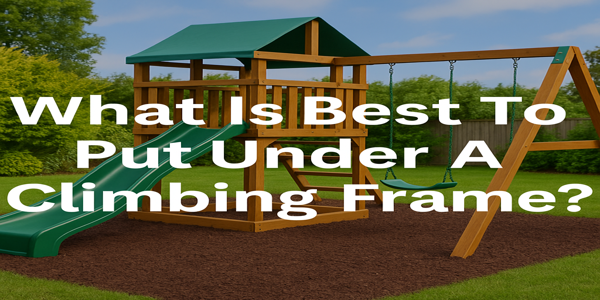
What Is Best To Put Under A Climbing Frame?
Tripped over a toy again? Us too. But when it comes to your garden climbing frame, safety’s no joke.
Quick answer: Rubber mulch or artificial grass with padding underneath are ideal—safe, long-lasting, and low-fuss. But grass? Absolutely fine in most garden setups. Want to know when to upgrade (and what to avoid)? Read on for the safest surfaces under those little feet.
As parents, we’re always trying to strike that magical balance—fun for the kids, peace of mind for us. Climbing frames? Brilliant. But let’s be honest: the ground underneath? That’s where the real decision happens. Because when they tumble (and they will), what’s beneath them makes all the difference.
This guide dives into your best options. Whether you're working with a big budget or scattering bark chips on a rainy Sunday, we’ve got the info to help you choose wisely.

Understanding Safety Surfacing and Critical Fall Height
The Purpose of Safety Surfacing
The frame gets all the glory, but the surface underneath is the true unsung hero. It cushions slips, stumbles, and superhero-style dives off the top bar.
Mitigating Injury from Falls
Let’s face it—kids fall. Whether they’re climbing too high or losing their grip mid-swing, it happens. Grass is generally safe for most home play equipment because of its forgiving surface and the lower height of garden climbing frames. But in wetter months or high-traffic areas, it can wear down and expose hard ground.
Meeting Safety Standards (e.g., EN 1177, ASTM F1292)
In the UK, standards like EN 1177 set out how well a surface must absorb impact. Fortunately, most garden climbing frames fall below the critical height threshold that would require specialist surfacing. Still, for extra durability or added peace of mind, many families opt for enhanced options.
What is Critical Fall Height (CFH)?
How CFH is Measured and Applied
Critical Fall Height is the maximum height a child could fall from. Surfaces are tested to see how well they reduce the impact from that fall. It's a technical process involving drop tests and impact sensors—far more precise than guesswork.
Matching Surface Depth to Equipment Height
Every safety surface has a recommended minimum depth. For example, rubber mulch might need to be 15 cm deep to safely cushion a 1.5 m fall. Always match your surface depth to the height of your climbing frame for proper protection.
The Importance of the "Safety Zone"
Recommended Clearances Around Equipment
It’s not just what’s underneath that matters. You also need a clear area around the frame, free from walls, fences, or flowerbeds. This “safety zone” ensures kids don’t crash into nearby obstacles during play. Swings usually require the largest buffer, while static frames like climbing walls need less.

Top Recommended Safety Surfaces for Climbing Frames
Loose-Fill Materials
Play-Grade Wood Chips or Bark
Natural-looking and affordable, bark or wood chips are easy to lay and blend nicely into most gardens. They provide good cushioning but break down over time, so expect to top them up—especially after a wet winter.
Rubber Mulch or Chippings
Made from recycled tyres, rubber mulch is softer, longer-lasting, and less likely to be displaced by energetic play or bad weather. It stays put, drains well, and won’t decompose like bark.
Pea Gravel and Sand (with considerations)
These offer a soft landing and some bonus sensory play, but they have downsides: sand can attract cats and shift easily, while pea gravel can pose a choking hazard for younger children.
Solid (Unitary) Surfaces
Wet Pour Rubber
Seen in schools and parks, this smooth, impact-absorbing surface is laid in place to match the fall height of your equipment. It’s extremely safe, drains well, and lasts for years—but it usually requires professional installation.
Rubber Tiles or Mats
A modular, DIY-friendly alternative to wet pour. Tiles come in various thicknesses and are great for patios or concrete bases. Easy to clean and simple to replace if damaged.
Artificial Grass with Shock Pad Underlay
Love the look of grass but want extra cushioning? This combo offers a tidy, all-weather surface that’s soft underfoot. The shock pad beneath meets fall height standards, while the artificial grass stays green and mud-free year-round.
Considerations for Each Surface Type
Cost (Initial vs. Long-Term)
Loose-fill like bark is cheaper upfront but needs regular topping up. Artificial grass, rubber mulch, and wet pour cost more initially but require much less ongoing maintenance.
Maintenance Requirements
Natural materials like bark and sand need raking and refilling. Rubber tiles and artificial grass are low-maintenance—just a quick sweep or hose-down every so often.
Durability and Longevity
Rubber-based options (mulch, tiles, wet pour) are the most durable. They don’t rot, attract pests, or wash away. Bark and sand will degrade over time and need regular refreshing.
Aesthetic Appeal and Drainage
Artificial grass gives a smart, clean finish that suits most modern gardens. Bark looks more natural, especially in woodland-style spaces. Just make sure whatever you choose drains well—nobody wants puddles under the monkey bars.

Factors to Consider When Making Your Choice
Budget and Installation Complexity
Loose-fill is easy for a weekend DIY project. Rubber mats are fairly straightforward, especially on flat ground. Wet pour and artificial grass with underlay are best left to professionals—but deliver excellent results.
Climate and Environmental Impact
Artificial grass can get warm in direct sun. Bark retains moisture in rainy weather. Consider your local climate and how each surface copes with heat, damp, and wear.
Specific Play Area Needs
For toddlers or children prone to falls, softer surfaces offer more reassurance. Older kids may need something durable enough for high-energy play. Think about how your children use the space—and plan accordingly.
Overall Garden Design and Aesthetics
Want a sleek modern finish? Go for artificial grass or rubber tiles. Prefer a natural look? Bark or woodchip blends into most garden settings. Choose what suits your style and your space.
Conclusion: Choosing the Right Surface for Your Garden Climbing Frame
In most cases, well-kept grass is absolutely fine—especially for climbing frames with low fall heights and regular supervision. But if you want something softer, tidier, or longer-lasting, options like rubber mulch or artificial grass with underlay are worth the investment.
Think about your family’s play style, how much maintenance you’re up for, and the look you’re after. Whatever you choose, a safe surface makes a big difference—and helps your children play with confidence.
Let the climbing, sliding, and tumbling begin—safely.
Have you checked out our other posts?
Can I Put A Climbing Frame In My Garden?
How High Can A Climbing Frame Be?
Can I Put A Climbing Frame On Artificial Grass?
Do Climbing Frames Need Planning Permission?
Can You Put A Climbing Frame On A Slope?
Can You Put A Climbing Frame On Concrete?



Leave a comment